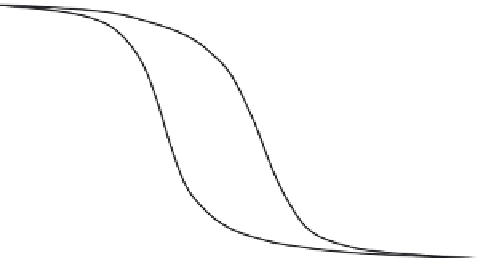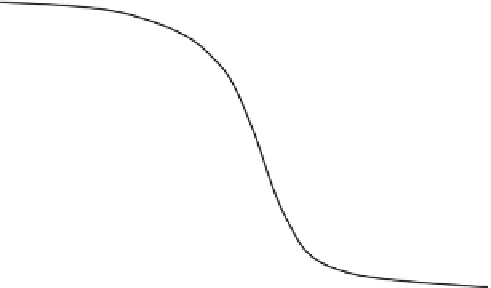Geoscience Reference
In-Depth Information
θ
Fig. 8.15 Typical drying and
wetting boundary
curves of the soil
water characteristic.
The value of the
water content
θ
01
is
saturation, and
θ
02
is
satiation; the
difference between
the two results from
entrapped air in
dead-end pores. The
figure also illustrates
how a fractional
volume of water
θ
θ
01
02
δθ
δθ
enters the soil during
wetting, as the soil
water suction
decreases from
H
w
+
δ
H
w
to
H
w
.
θ
r
δ
H
w
H = H
d
or H
w
A general discussion of hysteresis in physical terms was already presented by
Haines (1930). However, one of the first attempts to treat capillary hysteresis in soils
quantitatively was published by Poulovassilis (1962), who made use of the concept of
the independent domain, proposed by Neel (1942, 1943) and Everett (1954; 1955).
The effect of entrapped air
One obvious manifestation of hysteresis is often observed in experiments involving suc-
cessive and repeated drying and wetting cycles. As an illustration, consider the following
sequence illustrated in Figure 8.15. Assume that initially the soil is fully saturated and
that its water content is
θ
=
θ
01
; thus all its pores are filled with water so that
θ
01
=
n
0
which is the true porosity as defined in Equation (8.1). Consider that, next, the soil
is drained down to
θ
=
θ
r
by imposing a negative water pressure, and that it is then
subsequently rewetted by bringing the pressure back to zero. At this point the water
content will invariably not be
θ
02
. This difference can
be attributed largely to the presence of entrapped air in dead-end pores, from which it
cannot escape during the rewetting cycle. Usually, all subsequent drying and wetting
cycles will continue to take place between
θ
01
, but somewhat smaller, say
θ
02
and
θ
r
, and normally it will be impossible
to recover the original water content at
θ
01
. In carefully controlled experimental set-ups
in the laboratory the full saturation can only be achieved by taking special precautions,
such as the use of deaerated water or the passage of CO
2
through the soil prior to the
application of the water, or prolonged soaking or immersion. The water content
θ
02
is
often referred to as
satiation
, to distinguish it from the full
saturation
,
θ
01
. The two terms
are often used interchangeably. However, in field situations involving normal wetting
and drying processes, the water content at
H
=
0 is usually satiation.



















